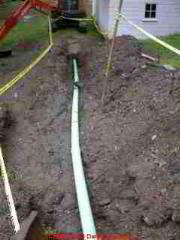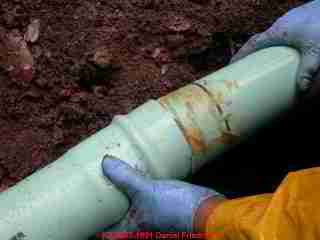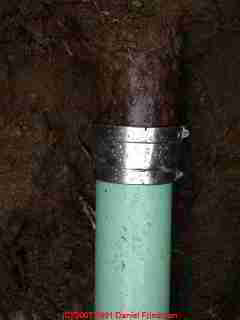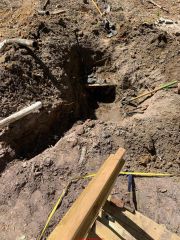 Sewer Line Installations on Steep Slopes
Sewer Line Installations on Steep Slopes
- POST a QUESTION or COMMENT about sewer or septic piping lines on steeply sloped sites
Sewer line installation or replacement on steep slopes:
This article describes the installation of drain lines on steep slopes between a house and the septic tank.
InspectAPedia tolerates no conflicts of interest. We have no relationship with advertisers, products, or services discussed at this website.
Guide to installing the replacement sewer pipe line at Steep Sites
 We present an actual case study, illustrated with photos of each step in the diagnosis and replacement of a blocked
sewer line.
We present an actual case study, illustrated with photos of each step in the diagnosis and replacement of a blocked
sewer line.
Proper drain line slope is important in avoiding septic or sewer line clogging and backups. Here we discuss
- Zig-Zag septic piping on steep hillsides
- U-turn septic piping on steep hillsides
- Septic piping along the fall line of a slope
- Steep septic designs used for sewer or septic piping replacement or new installations
What is the proper slope or pitch for a drain waste pipe? When wastewater flows at the correct speed in a drainpipe, the water carries the solid waste, feces and toilet paper, for example, along with the water out to the septic tank or sewer mains.
Plumbing codes and wastewater piping guides commonly specify that building drains should be pitched at 1/8" to 1/4" of slope per foot of linear run or distance.
[Click to enlarge any image]
Problems with steep drops between house and septic tank: But at a steep building site such as the property shown in our page top photograph, the drop in elevation between a building main drain and the septic tank inlet opening (or sewer main connection) may be so much that the slope of the waste piping will exceed the recommended limits for slope.
When installing a building drain line for wastewater, the wastewater flow rate we want is 2 feet per second. If waste flows in the sewer line faster than 2 fps, the risk is that water leaves the solids behind in the pipe where clogs may be recurrent.
If waste flows in a septic or sewage drain line more slowly than the desired speed, the risk is that is that listless flow leaves sewage which blocks the pipe.
ZigZagging Drain Line Piping Down a Slope
One approach to achieving the proper wastewater flow rate in a drain line down a steep slope would be to zigzag the pipe down the slope, making numerous turns.
My OPINION is that the added turns and length of this approach may increase the chances of future sewer line blockages, the zigzag drain line approach will also make it more difficult to clean out blockages, or you will need to add sewer line cleanout access points at every run and turn in the installation.
In short, a zigzag pipe run down a slope costs more, has more turns that risk clogging, is harder to clean out, takes up a lot more space on the site, and is usually not installed by contractors.
Straight-run Drain Line Piping Down a Steep Drop Slope between House and Septic Tank or Sewer Main
My experience is that many waste line installers simply install a straight sewer line from house to septic tank or house to sewer main, regardless of the building slope, provided that we have at least 1/8" per foot, preferably 1/4" per foot, or more.
Lower slope or nearly-flat drain lines are more likely to clog. On that side topic, if you're installing a drain line that may be sloped too little and you cannot easily remedy the situation, be sure to install extra cleanout access ports.
Experience in Installing Steep Sewer Drain Line Piping
Steep Drain Slopes May be Tolerable
 My OPINION is that if the total pipe run is steeper than what's normally specified, you might never see a blockage
My OPINION is that if the total pipe run is steeper than what's normally specified, you might never see a blockage
At the property shown in these photos and in the other photos in this series on sewer line replacement, the sewer line drops on a slope between 2” and 3” per foot over a 40 foot run between house exit line and septic tank inlet baffle.
This house-to-septic tank drain piping should be in the “danger zone” of leaving solids behind liquids during a toilet flush
But having managed this property for more than twenty years, we can say with confidence that we never had a problem with too-fast drainage blocking the waste line.
Blockages did not occur when the original waste pipe was constructed of jointed clay pipe.
Sewage blockages have not occurred since we replaced the original clay with plastic piping.
In our photo above the grease helps assemble the plastic sewer piping joint. The black line on the right hand pipe section tells the installer when the pipe sections have been fully joined.
I suspect that plastic drain piping is more slippery inside and has fewer joints to serve as obstructions, further reducing the chance of a blockage. The only problem we had with the line was when the old clay line was crushed and then blocked by mud
SO if you use plastic piping, straight runs, good smooth joints, you will probably be ok
Other Steps to Avoid Problems with Septic or Sewer Drain Lines on Steep Sites
- Septic or Sewer Drain Line Cleanouts: For convenience I’d add outdoor cleanout access ports to the sewer line every 20’ or so
- Proper septic pipe connections: Make sure that the new piping connections are made correctly, lubricated and fully seated during assembly.
- Proper sewer pipe directions: The receiving pipe hub or "female" end of the pipe is the next downhill section. Don't do this backwards or you invite leaks or clogging in your sewer line

- Use smooth drain line connections: the hub-less drain pipe connector shown in our photo was used to connect the new plastic waste line (running downhill to the septic tank) to the old cast iron waste line at its point of exit from the building.
It was important that these pipes be properly aligned (to avoid leaks at the connector) and that the connection and pipe ends be filed smooth to minimize the chances of waste line blockages at this point in the system.
.
Installing Septic Drainfield Piping on Steep Slopes is a Different Matter Entirely
Just to be clear, in this article we've discussed the installation of solid piping between a building and its septic tank or sewer main and we've said that steeper slopes may be ok.
But the possible "OK" for steep drain piping does not in any way apply to the perforated piping installed in a septic drainfield gravel trench.
Readers concerned with septic installation advice for steeply sloped or rolling sites should see these articles:
- See AEROBIC SEPTIC SYSTEMS, ATUs - home - some of these designs can work on steep slope sites
Or See HOOT Aerobic Systems Drip Disposal Design & Installation Guide [PDF]
Or
See "Guidance For Design, Installation And Operation Of Subsurface Drip Distribution Systems As A Replacement For Conventional Title 5 Soil Absorption Systems For Disposal Of Septic Tank Effluent", [PDF] Massachusetts Department of Environmental Protection (2006) refrencing MA regulations 310 CMR 15.240, 15.242, 15.247, and 15.280-15.289 - DOSING SYSTEMS PRESSURE which describes pressure dosing systems that may be useful for disposing of septic effluent at steep sites where the drainfield must be located either uphill or downhill from a septic tank or building.
- GRAVELLESS SEPTIC SYSTEMS- some gravelless systems can handle gentle curves necessary to follow rolling slope lines
- SEPTIC PUMPS Septic pumps, sewage ejector pumps, grinder pumps, effluent pumps, sump pumps, & septic pumping stations, septic pump alarms - systems that will be needed if a building or septic tank are lower than the drainfield or sewer main.
- STEEP SLOPE SEPTIC DESIGNS which describes installation of septic drainfields on steep or rolling sites.
Reader Comments, Questions & Answers About The Article Above
Below you will find questions and answers previously posted on this page at its page bottom reader comment box.
Reader Q&A - also see RECOMMENDED ARTICLES & FAQs
On 2021-07-31 by inspectapedia.com.moderator (mod)
@hi guy,
Wider sweep turns - 2 45s - will generally flow better than any sharper turn.
On 2021-07-31 by hi guy
On a corner that involves toilet waste flow. Better to make the 90° corner with a 1° drop rate per usual or if trenching allows 4" deeper depth, make the corner with 2, 45° corners while dropping the 4"? Thanks
On 2021-07-29 02 by inspectapedia.com.moderator (mod)
@Ted,
Start with your building or Health Department to find out what design they will consider acceptable in your country and community
On 2021-07-28 y Ted
Thinking of running 2, 1k gal tanks in a series, then pump out to, 2 sprinklers rather than installing an aerobic tank. We are short on service people for maintenance and our ground would be better served i think with a sprinkle system. Thoughts? Thanks
On 2021-07-23 by (mod)
@Ted
That doesn't sound like a problem to me. What does your contractor or septic engineer say?
On 2021-07-22 by Ted
@inspectapedia.com.moderator, yes of course not sanitary. Would that clarified liquid be fine to flow at sub-grade @ a 8' drop in 225'? Thanks
On 2021-07-22 0 by inspectapedia.com.moderator (mod)
@Ted,
If you are only moving clarified a fluid then there are should be no solids that would be left behind in the Wastewater. But you certainly cannot consider that water to be sanitary. That's a different point.
On 2021-07-22 by Ted
@inspectapedia.com.moderator, if raw sewage yes. What about if it's been in a septic tank breaking down like it would be going to a leach field. There is no sewage in that, correct? That is what would be going to the aerobic tank.
Thanks
On 2021-07-21 by inspectapedia.com.moderator (mod)
@Ted,
If a sewage line slopes more than 1/4" per foot the water tends to leave the solids behind;
You may need to go to a grinder sewage pump and force main;
On 2021-07-20 by Ted
We are installing a conventional tank near at our house. We are wanting to run the effluent to our aerobic tank 225 get away that's on place already. What is the maximum drop % wise per foot for the effluent line? The aerobic tank is about 8' lower than the conventional tank.
@Ted. Sorry, phone changed words
Thank you
On 2021-03-05 by danjoefriedman (mod)
@RENO,
I am guessing that by concrete pad you're referring to the floor slab of the home that you are building.
It's certainly common for sewer or septic lines to leave a building quite shallow in the soil and above the frost line. Of course those lines need to slope at the appropriate pitch to the ultimate location of the septic tank.
Otherwise the line will clog or freeze or both.
I recommend that you check with your local building authorities about exactly what is Required to be placed at a 4 foot depth.
On 2021-03-05 by RENO
I am going to build my own home , and do not choose to dig all of my trenches under my concrete pad at a depth of 4 feet , which is the required depth in my locality needed to legally exit from under the pad in my climate zone.
My question is can I trench shallower, and then drop vertically to the required 4 foot depth ?.This drop would be 30 -40 inches before exiting from under the concrete slab toa septic tank tank ,which will be about 10-15 feet from concrete pad.
On 2021-02-22 by ROBYN PARKHILL
Thank you, very helpful information.
On 2020-09-15 - by (mod) -
The drain line needs to have consistent and proper slope of 1/8 to 1/4" per foot and should have a number of access points or cleanouts along the run. The tank is usually located close to the building.
On 2020-09-15 by How would 500 feet to drain field be handled
How would the septic tank and pipes be arranged when the approved drain field area is 500 feet from the house. Also there is a rocky 40 foot hill along the run. The slope before and after the hill is relatively flat, sloping very gently towards the drain field. What are the issues involved and where should the septic tank be located.
On 2020-08-01 by sj
Is there known solution to the problem of a building site that sits in a swale below the city sewer lateral service point? (let's say 8 ft below) Other than the brute force approach of bring in hundreds of cubit yards of fills and compact it to raise the grade of the building site?
On 2020-04-02 - by (mod) -
 Eddie
Eddie
A septic tank just 18-inches from a building foundation is a bit close; How did you construct the new building without either damaging the septic tank or having the tank compromise the foundation?
A 40 inch drop over 18" into a septic tank, once you add the necessary elbows, essentially vertical. The risk is that solids falling vertically can stick and clog the piping - though using 45's instead of 90 degree elbows can reduce the trouble.
Similarly the fast flow of waste into the septic tank risks clogging at the tank inlet baffle.
I would start by having the tank inspected to determine in this order of importance
- Safety: are the tank cover and access opening covers safe against a collapse and someone dying by falling-in?
- Septic tank condition and materials: is the tank sound or is it home made out of block or made of rusting steel; what are the condition of the baffles and protection from groundwater leaks
- Function: what are the tank size and how does that compare with the daily wastewater flow?
- What is the condition of and capacity of the drainfield?
On 2020-04-02 by Eddie
My septic tank is 16’ away from my home however the drop is about 40” is this an acceptable drop? If not how do I fix this? This is an old septic tank in which I was grandfathered use of.
On 2020-03-25 - by (mod) -
Anon:
at 1/8" slope per foot, .125 x (120 ft) = about 15 inches
at 1/4" solpe per foot of run, 0.25 x 120 = about 30" of drop
Shaun: the limits are basically set by how much space you have along with where along slope you're putting turns and other components.
On 2020-03-24 by Anonymous
What is the pipe drop when septic tank is 120 feet away
On 2020-03-10 by Shaun
Hey,
My team wants to build a septic system, but we need to work out the details for the drop boxes we are including for the steep slope. How steep can the pipes be from drop box to drop box? Is there a limit? Is there a limit for how long the pipe can be as well, besides how steep? Are there regulated dimensions for a drop box?
Please let us know!
Thanks
On 2019-08-01 - by (mod) -
too much downslope on a septic or sewer line.Thanks for a useful and interesting question, Verne, the problem of too much downslope on a septic or sewer line.
I've seen plenty of sewer lines that were way too steep (1/8" to 1/4" drop per foot of run is recommended) but that were short - just a few feet to a septic tank, and where any bends were kept gentle, and that don't seem to clog.
The problem with longer stretches of excessive slope sewer piping is that the liquid waste will sometimes run ahead of the solids in the line. Especially with a long 300 ft line that's asking for clogs in the sewer line and backups in the cabin.
One of the most useful aphorisms I offer, at least for the building construction and mechanicals field, is that it's rarely the case that you're going to run into a problem that no one has encountered before. What's left is to find what are the best known solutions.
One solution you'll read about on this page is that the sewer line gets even longer, zig-zagging across the steeper sloped sections.
Also be sure to use gentle turns, 45s at most, a sharp bend in a sewer line combined with high velocity waste is also likely to lead to clogs. I'll leave the graphic details to your imagination.
Finally, you could convert the whole thing to a "force main" with a sewage grinder pump and probably some check valves but that may be an unnecssary expense also adding complexity we'd prefer to avoid. Let's take the question to your septic installer to hear what she thinks.
See details at SEWAGE PUMPING STATIONS
On 2019-08-01 by Verne
Hello, I have a question about a toilet being installed in a cabin about 300 feet from the main house/septic tank and field. The cabin is gradually uphill from the septic tank, but at times the slope is quite a bit more than 1/4 inch per foot. Given the long distance to get the effluent to the tank, is too much slope a problem in this situation? Or is it okay to have some stretches that are more than 1/4 inch per foot? Would installing a sewage pump help at all in this situation, given that the septic tank is downhill from the toilet?
On 2019-05-23 - by (mod) - septic or sewer line sloped the wrong way
JImmy
A sewer or drain line sloped in the wrong direction is going to have repeated clogs and in a freezing climate risks freeze-up, breakage, or worse a sewer backup into the building.
The whole sewer line ought to be inspected (perhaps with a sewer camera) and any slope errors should corrected.
On 2019-05-21 by Jimmy
The drain pipe at the point it goes out of the house is slightly slopes to the inside of the house
It stays full all the time.
Several times it has clogged at some point from house to septic tank.
Should I have the angle redone coming out of the house?
On 2019-02-08 - by (mod) -
Anon
I don't know as I don't know what sort of septic system we're discussing, nor where the pump and drainfield are, nor what slopes, distances, etc. are involved, but I SPECULATE that you're asking about a check valve that would be used to prevent up-sloping pipes from draining backwards into the septic pump or effluent pump system.
On 2019-02-08 by Anonymous
What kind of valve goes from the pump to the drain field
...
Continue reading at STEEP SLOPE SEPTIC DESIGNS or select a topic from the closely-related articles below, or see the complete ARTICLE INDEX.
Or see SEWER / SEPTIC LINES for STEEP SITES FAQs - questions & answers posted originally at the end of this page.
Or see these
Steep Slope Septic System Articles
- DIFFICULT SEPTIC SITE DESIGNS
- SEPTIC CONSULTANTS, DESIGNERS, ENGINEERS
- SEPTIC SYSTEM DESIGN ALTERNATIVES - home
- SEPTIC SYSTEM DESIGN BASICS - home
- SEWER / SEPTIC LINES at STEEP SITES
- SOIL PROPERTIES & BUILDING FAILURES
- STEEP SLOPE SEPTIC DESIGNS
Suggested citation for this web page
SEWER / SEPTIC LINES at STEEP SITES at InspectApedia.com - online encyclopedia of building & environmental inspection, testing, diagnosis, repair, & problem prevention advice.
Or see this
INDEX to RELATED ARTICLES: ARTICLE INDEX to DRAIN SEPTIC SEWER PIPES
Or use the SEARCH BOX found below to Ask a Question or Search InspectApedia
Ask a Question or Search InspectApedia
Try the search box just below, or if you prefer, post a question or comment in the Comments box below and we will respond promptly.
Search the InspectApedia website
Note: appearance of your Comment below may be delayed: if your comment contains an image, photograph, web link, or text that looks to the software as if it might be a web link, your posting will appear after it has been approved by a moderator. Apologies for the delay.
Only one image can be added per comment but you can post as many comments, and therefore images, as you like.
You will not receive a notification when a response to your question has been posted.
Please bookmark this page to make it easy for you to check back for our response.
Our Comment Box is provided by Countable Web Productions countable.ca
Citations & References
In addition to any citations in the article above, a full list is available on request.
- New York State Department of Health, APPENDIX 75-A WASTEWATER TREATMENT STANDARDS - INDIVIDUAL HOUSEHOLD SYSTEMS , [PDF] New York State Department of Health, 3 February 2010, retrieved 3/1/2010, original source: https://www.health.ny.gov/regulations/nycrr/title_10/part_75/appendix_75-a.htm
- Thanks to Thomas Gleason, excavators, Poughkeepsie, NY 845-454-3730, for the excavating work at the project photo documented here in September 2006
- Thanks to Cleveland Plumbing, the prime plumbing contractor, Staatsburgh, NY 845-485-7700 for the plumbing work and drain clog diagnosis work documented here in September 2006
- In addition to citations & references found in this article, see the research citations given at the end of the related articles found at our suggested
CONTINUE READING or RECOMMENDED ARTICLES.
- Carson, Dunlop & Associates Ltd., 120 Carlton Street Suite 407, Toronto ON M5A 4K2. Tel: (416) 964-9415 1-800-268-7070 Email: info@carsondunlop.com. Alan Carson is a past president of ASHI, the American Society of Home Inspectors.
Thanks to Alan Carson and Bob Dunlop, for permission for InspectAPedia to use text excerpts from The HOME REFERENCE BOOK - the Encyclopedia of Homes and to use illustrations from The ILLUSTRATED HOME .
Carson Dunlop Associates provides extensive home inspection education and report writing material. In gratitude we provide links to tsome Carson Dunlop Associates products and services.

